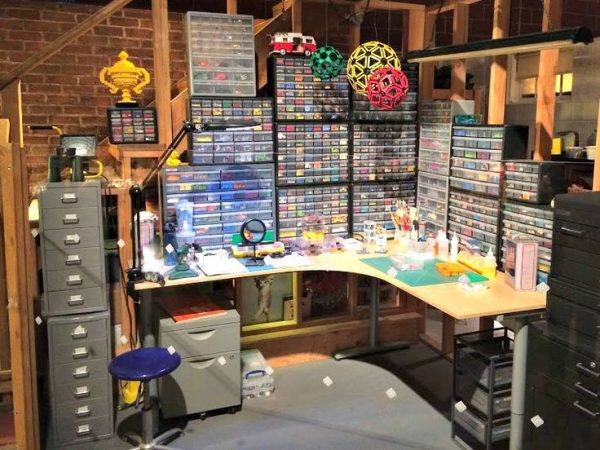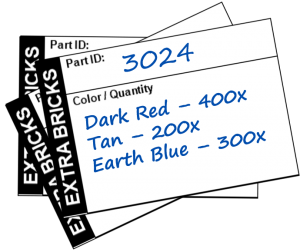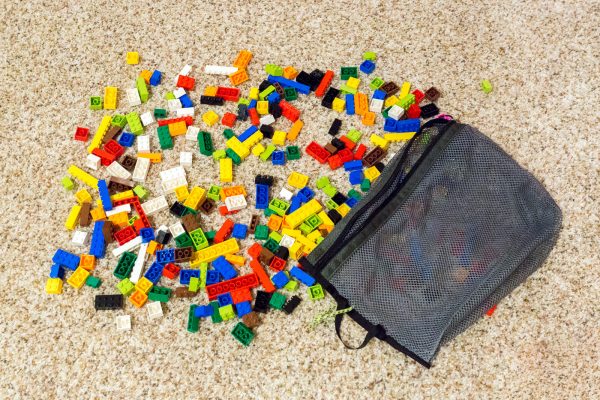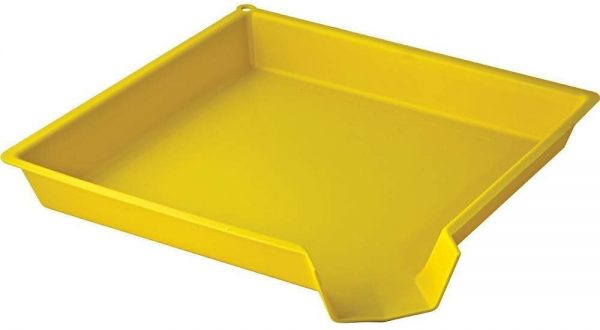Chapter 6: Additional LEGO Brick Storage Tips & Tricks
Planning for growth
As your LEGO collection gets bigger, your storage requirements will grow. Likewise, as you (or your child) become more experienced LEGO builders, you might want a more organized storage solution to make it easier to find specific parts. This is why it’s a good idea to put some thought into the growth of your collection before spending a lot of money on LEGO storage.
The easiest way to plan for growth is to allow for plenty of empty space in the storage solution that you buy now. A good rule-of-thumb is to ensure that each container in your storage solution is about half full when you organize your collection. This leaves a lot of space for new parts before you need to upgrade your storage solution.
It’s not just about leaving room in each container for more bricks… If you sort your collection by part, you will need to add additional storage as you buy new parts, especially since LEGO introduces new parts every year. (In the last 5 years, LEGO has introduced about 30 new general-purpose elements every year; that’s not including the hundreds of new printed tiles, minifigure accessories, and one-off parts created for licensed sets.)
Another good idea is to look for modular storage solutions. If you are using plastic drawer cabinets, you can start with just a few cabinets, and add additional cabinets as your collection grows. Do be wary of purchasing discontinued or off-brand storage solutions—you probably won’t be able get more when you need them. (A common complaint of LEGO builders is that they have mismatched storage solutions. This makes cabinets harder to stack, don’t look as attractive, and you can’t quickly rearrange parts without also changing their containers.)
Using Multiple Storage Systems
While there are good reasons to use the same LEGO storage solution for your entire collection, this may not be practical for several reasons.
- You might decide to re-purpose older storage solutions for seldom-used parts after upgrading to a nicer storage solution.
- You might need containers with larger compartments for your most common parts.
- You might decide to store seldom-used parts in a cheaper storage solution or a less convenient location.

Fans of The LEGO Movie will recognize Lord Business’s basement. Remember, it isn’t a toy, “it’s a highly sophisticated inter-locking brick system.”
You may also decide to keep part of your collection separate… I keep a complete set of 21050 Architecture Studio at work for lunch breaks, boring phone calls, stressed-out colleagues, or for their kids to use if they need to come into the office. (It’s in a single tackle box with removable containers, organized by category.)
Maintaining an Index
If you have a large collection, you might want to maintain an index to help you keep track of which bricks you have, and where they are stored. In the extreme case of collections sorted by element (separated by both part + color), you might store different colors in a different place.
A quick way to do this is to print the Contact Sheet based on my LEGO Brick Labels collection. You can circle all of the parts that you own, or you could write the storage location in your collection next to each part in the Contact Sheet. (It works even better if you sort your collection into the same groups used in the Contact Sheet.)
- Contact Sheet – Keep track of the parts you have, and where they are stored by printing this contact sheet and writing notes next to each part.
A few LEGO Enthusiasts maintain a digital inventory of the LEGO parts. This is possible using the BrickLink website by marking the inventory as part of your “Stockroom” (Ensuring that the parts aren’t available for others to purchase). Alternately, you can use the BrickStock app to keep track of your inventory.
Whether you use BrickLink or BrickStock, you can use the “remarks” field to indicate where the parts are stored in your collection.
Cross-referencing
If your storage solution includes an overflow storage location when the primary storage is too full, or if you keep new bricks separate from old bricks, you might want to implement a simple cross-referencing solution. This helps you remember that there are additional bricks of this type stored in a different location. (It’s pretty annoying to order more bricks, only to realize that you already had an extra bag stored somewhere else.)
I designed a simple paper card which is small enough to fit in the smaller Akro-mils drawers. I just write the approximate quantity of each color on the card, indicating that I have more of that Element (Part + Color). Extra LEGO bricks are stored in plastic bags within inexpensive Sterilite drawers.
- Extra_Bricks_Redirect.pdf – Put one of these small cards in your storage drawer or container when it is full and you have extra bricks stored somewhere else.
Cleaning LEGO
If your LEGO pieces are dirty or you purchased a large lot of used LEGO for a nice price, you may want to wash the LEGO bricks. While LEGO bricks are quite durable, you can’t expect them to look “like new” because used bricks often have small scratches along the edges, or indentations from using fingernails or teeth to separate bricks. The colors which seem to be most susceptible to fading, scratches, and visible wear are 1White and 26Black pieces.
Washing LEGO is easy!
- Put LEGO Bricks into a fine mesh bag with tight closure.
- Put bag into washing machine with other laundry and regular laundry soap. Run at a “Gentle” setting, as higher temperatures can damage your LEGO bricks.
- After washing, lay bricks out on a towel or carpet to dry.
Use extra caution if you have a top-loading washing machine — parts can be broken or scratched more easily by the agitator. Some people suggest using a dishwasher instead of the washing machine to prevent bricks from get tumbled against one another. (This works especially well for larger Duplo / Quatro bricks.)
- XL Laundry Bag – This is the top-rated laundry washing bag on Amazon, with zippered closure that works well for cleaning LEGO.
Please note that The LEGO Group does not advise washing your LEGO bricks in this way. “We recommend that you clean your LEGO® parts by hand using water no hotter than 104°F / 40°C and a soft cloth or sponge.” (Source: LEGO.com)
Funnel Tray
If your LEGO collection is sorted by category, or you sort by part and need to find the right color, it can be frustrating to find the part you need. That’s why you need a funnel tray — It allows you to dump out a whole bag or drawer of pieces, spread them out to find what you need, and quickly dump all of the pieces back into the storage container without making a mess.
Since funnel trays are inexpensive and stackable, I suggest keeping a few of them around your LEGO build area.
- Funnel Tray – A Funnel Tray makes it easier to find a specific part or color.
LEGO Ruler and Sorting Tool
With some practice, you will be able to immediately recognize the difference between a 1×3 and 1×4 brick, but it’s really hard to quickly identify the difference between a 1×12, 1×14, or 1×16 without counting the studs. That’s why I created a simple LEGO sorting tool, which you can print on thick paper, or print and laminate.
If you place a few copies of the LEGO Ruler and Sorting Tool around your build space, you will be able to quickly measure LEGO parts at any time. As you can see, it also includes a guide to help sort common Technic pieces.
- LEGO_Ruler.pdf – It’s easier to sort a lot of LEGO using a ruler.
NOTE: Be sure to print it at “100%” scaling factor. The PDF is designed to fit on both USA 8.5×11 inch and European A4 Paper.
New vs. Used bricks
Some LEGO builders keep brand new LEGO bricks separate from used bricks. This might be to help you find pristine bricks when making a model which will be photographed, or because you sometimes sell excess bricks on BrickLink.
Either way, if you wish to keep New & Used bricks separate, you will need a way to keep them separate. An easy way to do this is to keep new bricks in a small Ziploc bag alongside used bricks.






Have really enjoyed your book and storage guide. I would love to see a section in the guide on sorting. What’s the most efficient way to go from a giant pile of random parts to get them sorted into bins? Some recommendations on sorting sieves or other options is what I was hoping to find.
I have not tried a sorting sieve, but most of the LEGO enthusiasts that I know who tried it have said it doesn’t help much, and you end up scratching up your bricks trying.
Best suggestion is to sort in multiple passes, while watching TV or a movie. Good luck.
P.S. This article explores the topic further: http://tomalphin.com/2014/03/from-buckets-to-bins-how-to-sort-a-lot-of-lego.html
For those looking for a convenient “sifter,” I’ve had decent success with a cookie COOLING RACK. I used one with a grid (some have only parallel wires.) The curved “feet” fit pretty well over my Sterilite drawers & the slightly longer length made it easy to slide the big pieces off into another bin. When my kids leave stuff on the floor, it goes into a big bin, so when I get ready to sort it back into drawers, I just scoop handfuls on top of the rack, shuffle & slide the big stuff over the edge. Saves a lot of time–only problem is deciding whether 1x? plates should go in the small stuff!
For initial sorting of widely varied types of bricks, has someone devised a sieve that would allow, say, 2×4 bricks and smaller to fall through but not larger pieces? I’m not sure where the balance is, but I know there are MANY more small pieces than large pieces, but the large pieces make it more difficlut to find the small pieces when using a very simplistic gross-sort organization method. And today the kids are too young for the OCD level of organization I would like to employ, but something as simple as: Plates >4x, Wheels & axle related pieces, small pieces, and minifigures & accessories would be a great start … but sorting the small parts out is kinda challenging.
There are some sorting trays where you shake the pieces and the smallest parts fall to the bottom. I’m not sure how much this helps in sorting a large collection of bricks, though.
If you have a bunch of spare boxes laying around, you don’t need to buy a plastic funnel tray. Instead simply cut open a corner of a box and make your own funnel. It’s rare that I don’t have any spare boxes around. They usually get thrown away if I don’t reuse them.
I use Rebrickable.com for managing my loose parts inventory and BrickSet.com for all my sets. Everything gets merged at Rebrickable.com and I can easily back it all up to an XLS (Excel) file on my PC. At the moment, I’m not interested in selling my inventory. As such, I don’t really have use for the BrickStock app nor using the store functions on BrickLink.
When the “Lego tape” came out a while ago, my first thought was that it could be cut into small pieces and stuck on drawers, and then one of each type of brick that was in the drawer, attached to the tape.
That way, if you need to rearrange the drawers, you won’t need new labels, just replace the brick(s) on the tape.
Austin,
Have you tried it? I would be worried that the adhesive from a 4-stud long section wouldn’t be sufficient to hold a 2×4 brick or plate for a long period of time. I’d love to hear how it works!
—tom
No sir, I don’t have any of the tape. If like they claim, you can build on walls, I guess it should be able to hold a brick that’s not being played with/built on. But who knows without owning some! 🙂
My second comment, really enjoying your book, BTW. A cheap way to get a funnel tray is to take a sturdy lid and cut a corner off. If you are careful, you can also create a “flip down” corner.
Thank you for the great work you did so far.
Considering the growing number of colors TLG has produced (and still is),a brick built color chart is a very usefull tool when it comes to sort. I mean are you really able to differenciate lavenders / violet , blues or shades of orange under mediocre light without such a tool?
Didier,
I definitely have a brick-built color chart – actually I have two! This is a good idea to add to the guide. I’ve added this to the todo list in the appendix.
What I am most bugged about is official LEGO element color names. I want to find a way to accurately print am official color list so it’s easier to search for certain elements by color. Otherwise I like this info. I use a lot of cardboard food container display boxes to sort out stuff before final sorting into other containers. Even use cigar boxes for some stuff
It isn’t possible to print a perfectly accurate LEGO Color List, because printed color is never going to look quite the same as plastics with the color embedded within the plastic. That’s why the best way to go is to build your own LEGO Color Palette. I’m going to add this to the tips and tricks section soon.
—tom
Congrats! This is really a great work. We all think of this issue but usually never put and gather all the storage solutions and thoughts into one single document. I have but only 4 comments on this matter:
1.- I prefer to sort my collection by set rather than category because I can’t really memorize all 100,000 different elements in my collections. When I’m looking for an specific piece I just go to Brickset or Rebrickable to see in what sets I own is the piece in and simple search for the Ziploc bag I have that set. I do believe sorting by set is also a great way to organise and should have a space in this guide.
2.- Inventory it’s almost as important as sorting and organising your collection and also Management and Databases should appear in this guide.
3.- I’ve noted storing built minifigs occupy aprox. 30% less space than unassambled, which is a far mor efficient percentage of storage than brick and pieces. I know keeping LEGO pieces built for storage damage the clutch power, but I do believe Storage Time to be a main factor when speaking of storage solutions. I only storage disassamble when I know i won’t be using that set or pieces for quite a long time, specially with minifigures.
4.- I’ve noted identifying the LEGO system the pieces you’re storing and organising can really help you saving some space and time. It’s not the same to sort and store DUPLO, System pieces, BIONICLE pieces and Technic pieces. DUPLO occupies so much space, BIONICLE is really easy to sort by part and, in some extremily cases, by element and Technic usually occupies far less space rather than System. I’ve found storing your pieces by the LEGO system they belong helps you all the way.
Anyway, I’m currently suffering from space, storage and sorting of BIONICLE pieces, since I’m working with that and putting a little bit aside System or Technic. I’m really happy I came across your book and I’m looking forward to se a physical version.
Congrats from Mexico!
MAFOL,
Thanks for the kind words about the guide! It’s been a pleasure the hear that it is helpful to so many people. Your comments were thoughtful, so I wanted to reply to each of them…
1) I am planning to add an additional section on storing and displaying complete LEGO sets in the future.
2) I talked about keeping an inventory here: http://brickarchitect.com/guide/bricks/more/#maintaining_an_index It mentions Bricklink website and brickstock app. I’ll probably wait and see if this is an issue lots of people want to hear more about.
3) I am fairly confident that brick fatigue is a real issue for stud connections, but have not seen any proof of damage when minifigures remain assembled for a long time. I think you are probably OK.
4) This is an area I want to discuss further – I hoep to add a section near the beginning explaining that LEGO is not one system, but several systems: LEGO System, LEGO Technic, LEGO Bionicle, LEGO Duplo, etc… (Galidor/Znap anyone?)
Good luck with organizing your BIONICLE pieces!
This is a very interesting guide, kudos for putting it together and sharing it! To try to broaden the vendor recommendations outside the US: I would recommend Muji for (larger) storage drawers in Asia. Unfortunately their website is impossible to use so I can’t find a direct link to the products, but they make a large selection of drawers and boxes. Not cheap, unfortunately, but good quality and stackable, which is useful for anyone living in a small space.
Personally I’d find it useful if you could offer some advice on what sizes are most useful, I originally bought a lot of very small drawers but now I find even sorting by piece a lot are outgrowing the drawers, and I should have given up more space to larger units. I find the most useful are 15 x 10 x 2 cm (or thereabouts – I have a variety of cheap sets but haven’t found a good brand), and then 25 x 16 x 6, and 25 x 32 x 6 (the Muji drawers).
Any tips on fitting lego collections into smaller houses / spaces would also be appreciated!
What are thoughts on storing bricks stacked? does this reduce clutch power over time? It is more efficient than lose storage, especially for growing collections in a limited space?
Stacking bricks while in storage can reduce clutch power over time. It is slightly more efficient, but not recommended. (I already plan to discuss this in a future update – it’s on the backlog of future improvements in the appendix.)
Thanks for the feedback…
—tom
Is that something there is actual research on or just something everyone knows? Is that based around the research that has been done about clutch power after repeated connection/separation events? (IIRC around 30,000 events results in measurable loss) I do store my common bricks in stacks as a way of color sorting and being able to do quick counts due to the consistent stack size and haven’t noticed any reduction in clutch, but then I’ve only had them in stacks for maybe 5 years.
I have definitely experienced parts which have cracked after a model was left assembled for only a few years. The most common bricks to crack in my experience were 1×1 Cheese, 1×1 Headlight Brick (Erling), and the standard 1×1 Brick. That said, I have not seen a definitive article exploring the topic of cracked bricks or brick fatigue caused by leaving a model assembled for too long.
On a related topic, here’s an experiment exploring clutch power degradation after repeatedly snapped together and removed: https://hackaday.com/2013/04/19/measuring-the-lifespan-of-lego/
—tom
P.S. Since I couldn’t find any definitive answers, I asked Brickset readers what they have experienced – http://bricksetforum.com/discussion/27453/brick-fatigue-or-cracking-when-model-remains-assembled-too-long/
For drying, the best thing I’ve found is a food dehydrator with stackable trays. It gets the water out of all the small cavities in a matter of hours.
For washing, I’ve always used a dishwasher because it doesn’t have an agitator. I’m afraid of a rock-tumbler effect in the washing machine. I don’t recommend washing chrome (it comes off) or printed parts (they can fade). Otherwise, I haven’t had any trouble.
Good tips. I’m hesitant to “recommend” the food dehydrator for concern that the heat would damage bricks, but I did add the suggestion to consider using the Dishwasher instead of the washing machine to clean bricks.
I think you are right that top-loading washing machines with an agitator present an extra risk.
Tom, I really like the ruler but wonder if it would be possible to could include something to measure a slope angle.
I recommend Brickset for set inventory, which automatically downloads to Rebrickable where I add my loose part (bulk) inventory.
Some really useful tips. If anyone finds a source for the funnel tray in Europe, please share!
I find Ikea Variera drawer organisers great for sorting parts, and their shape makes them nice for pouring into drawers or bags after: http://www.ikea.com/ie/en/products/kitchen-products/kitchen-organisers-shelves/variera-box-green-grey-art-90335107/
The cross-reference cards and the funnel tray are really good suggestions. Never heard of them funnel trays before.
I’m glad to hear that these suggestions were new for you, and I hope they make you a happier (and more creative) builder!
—tom
Hi! I know I left several comments about typos — I hope I did not offend. Your book is really helpful and I’m sure you want it to be the best representation of you and your work as possible. This information is invaluable! The way you organized the information definitely reflects the LEGO storage/organization journey we have experienced in our home. I am in the process of building a storage cabinet for my son and will be doing the sorting within the next few weeks. All of the extra materials you mentioned or provided will be of extreme help. The ruler, redirect card, and labels are amazing and I thank you for sharing them with us.
Best of luck with your new book!
Ella, thank you for the kind words about the resources which I have provided in this guide. I am so happy to hear that they are useful to you.
I also want to thank you for the corrections. I haven’t done a thorough editorial pass yet as I’m still working on building up the library of content, but I’m always happy to correct errors like this. Keep the editorial feedback coming! (I deleted your comments identifying specific errors, but only after fixing the text.)
Sincerely,
—tom
That ruler is just so brilliant and will help me out in the workshops I do with (young) children so much, thanks!
Love the book…it looks good! You did an awesome job mentioning lego organization by size and use. My lego collection has grown over the years to a very large collection and I use a little of all of these ideas. Also great reference to vendors you have found that sell the organization solutions. I think that was the hardest part of the whole process when I started. I put together adequate solutions in a creative way, piecing together parts from many different storage solutions. Again, great read and I think it will be helpful for those interested in this topic.